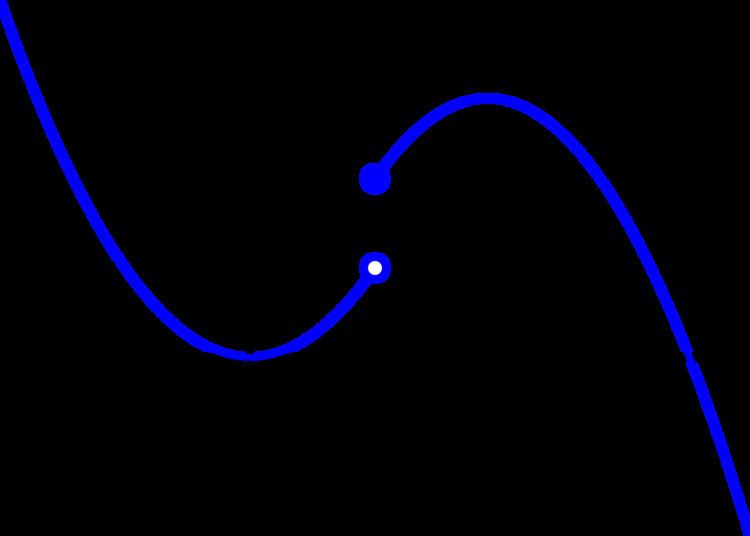 | ||
In mathematical analysis, semi-continuity (or semicontinuity) is a property of extended real-valued functions that is weaker than continuity. An extended real-valued function f is upper (respectively, lower) semi-continuous at a point x0 if, roughly speaking, the function values for arguments near x0 are either close to f(x0) or less than (respectively, greater than) f(x0).
Contents
Examples
Consider the function f, piecewise defined by f(x) = –1 for x < 0 and f(x) = 1 for x ≥ 0. This function is upper semi-continuous at x0 = 0, but not lower semi-continuous.
The indicator function of an open set is lower semi-continuous, whereas the indicator function of a closed set is upper semi-continuous. The floor function
A function may be upper or lower semi-continuous without being either left or right continuous. For example, the function
is upper semi-continuous at x = 1 although not left or right continuous. The limit from the left is equal to 1 and the limit from the right is equal to 1/2, both of which are different from the function value of 2. Similarly the function
is upper semi-continuous at x = 0 while the function limits from the left or right at zero do not even exist.
If
Let
Formal definition
Suppose
We say that
For the particular case of a metric space, this can be expressed as
where lim sup is the limit superior (of the function
The function
We say that
where
The function f is called lower semi-continuous if it is lower semi-continuous at every point of its domain. A function is lower semi-continuous if and only if
Properties
A function is continuous at x0 if and only if it is upper and lower semi-continuous there. Therefore, semi-continuity can be used to prove continuity.
If f and g are two real-valued functions which are both upper semi-continuous at x0, then so is f + g. If both functions are non-negative, then the product function fg will also be upper semi-continuous at x0.
The composition f∘g of upper semi-continuous functions f and g is not necessarily upper semi-continuous, but if f is also non-decreasing, then f∘g is upper semi-continuous.
Multiplying a positive upper semi-continuous function with a negative number turns it into a lower semi-continuous function.
If C is a compact space (for instance a closed, bounded interval [a, b]) and f : C → [–∞,∞) is upper semi-continuous, then f has a maximum on C. The analogous statement for (–∞,∞]-valued lower semi-continuous functions and minima is also true. (See the article on the extreme value theorem for a proof.)
Suppose fi : X → [–∞,∞] is a lower semi-continuous function for every index i in a nonempty set I, and define f as pointwise supremum, i.e.,
Then f is lower semi-continuous. Even if all the fi are continuous, f need not be continuous: indeed every lower semi-continuous function on a uniform space (e.g. a metric space) arises as the supremum of a sequence of continuous functions.
Likewise, the pointwise infimum of an arbitrary collection of upper semicontinuous functions is upper semicontinuous.
The indicator function of any open set is lower semicontinuous. The indicator function of a closed set is upper semicontinuous. However, in convex analysis, the term "indicator function" often refers to the characteristic function, and the characteristic function of any closed set is lower semicontinuous, and the characteristic function of any open set is upper semicontinuous.
A function f : Rn→R is lower semicontinuous if and only if its epigraph (the set of points lying on or above its graph) is closed.
A function f : X→R, for some topological space X, is lower semicontinuous if and only if it is continuous with respect to the Scott topology on R.
Any upper semicontinuous function f : X→N on an arbitrary topological space X is locally constant on some dense open subset of X.
The maximum and minimum of finitely many upper semicontinuous functions is upper semicontinuous, and the same holds true of lower semicontinuous functions.
